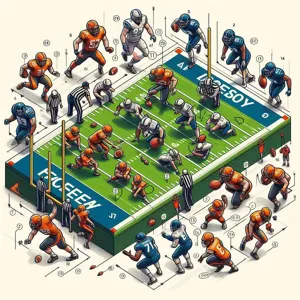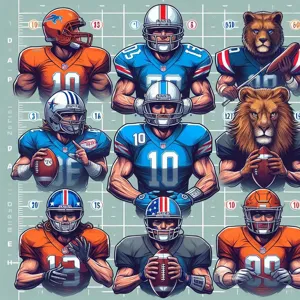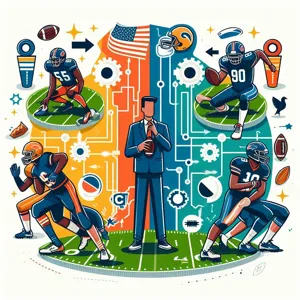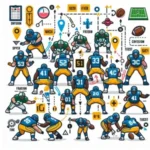American football is a symphony of strategy, skill, and teamwork, where every position on the field plays a vital role in orchestrating a successful game plan.
From the thunderous tackles of the defensive linemen to the agile footwork of wide receivers, each player brings a unique set of skills that contributes to the overall performance of the team. Understanding the intricacies of these positions not only enhances your appreciation for the game but also illustrates how the collaboration of various roles fuels success on the gridiron. In this ultimate playbook, we will delve into the responsibilities, strategies, and impact of each position, shedding light on how these players work together to create a cohesive unit. Whether you’re a seasoned fan or a newcomer to the sport, this guide will equip you with insights into the essential dynamics of American football, revealing how each role is crucial to achieving victory.
1. Introduction to Team Success in American Football

American football is a symphony of strategy, skill, and teamwork, where each position plays a pivotal role in orchestrating a successful performance on the field. As fans, we often marvel at the explosive plays, the dramatic touchdowns, and the nail-biting last-minute drives that define the game. However, the underlying foundation of these moments lies in the intricate dynamics of team cohesion and the specialized functions of each player.
In this high-octane sport, success is not determined by individual talent alone but by the seamless collaboration of diverse roles, each contributing its unique strengths to the collective effort. From the quarterback who orchestrates the offense, making split-second decisions, to the linemen who create the critical barriers against the opposing team, every position is essential in achieving victory.
Understanding how each role interacts and supports one another is crucial for grasping the complexity of football. The synergy among players, the strategic deployment of their skills, and the execution of finely-tuned game plans all culminate in a well-oiled machine that can adapt and thrive under pressure. In this playbook, we will delve into the specifics of each position, exploring how their unique contributions fuel team success and shape the outcome of games. Whether you are a seasoned fan or a newcomer to the sport, by the end of this journey, you will appreciate the art of teamwork in American football as more than just a game—it’s a meticulously crafted performance where every player has a part to play.
2. Overview of Football Positions
American football is a symphony of strategy, skill, and teamwork, where each position plays a crucial role in the overall success of the team. Understanding these positions can illuminate how they contribute to the dynamic flow of the game, and why each player’s abilities are integral to the team’s performance.
**Offensive Positions:**
At the forefront of the offensive lineup is the **Quarterback (QB)**, often seen as the leader on the field. The QB is responsible for orchestrating plays, reading the defense, and making split-second decisions that can change the course of a game. They must possess not only exceptional throwing skills but also the ability to remain calm under pressure.
The **Running Backs (RB)**, including both halfbacks and fullbacks, are the workhorses of the offense. They are pivotal in executing running plays, providing both speed and power. Their agility allows them to navigate through defensive linemen and find gaps to advance the ball, making them essential for both rushing and receiving plays.
**Wide Receivers (WR)** are the speedsters of the field, tasked with catching passes from the quarterback. Their route-running precision and hands are vital for converting third downs and scoring touchdowns. A skilled WR can stretch the field, creating space for other players and keeping defenders on their toes.
On the other end of the line, the **Tight Ends (TE)** serve a dual purpose. They can block like offensive linemen or run routes like receivers, providing versatility to the offense. This multifaceted role makes them crucial for both the passing and running game.
The **Offensive Line (OL)**, consisting of the center, guards, and tackles, is the backbone of any offense. These players are tasked with protecting the quarterback and creating holes for the running backs. Their ability to work cohesively in blocking schemes is essential for maintaining a successful offense.
**Defensive Positions:**
On the flip side, the **Defensive Line (DL)**, comprising defensive tackles and defensive ends, is essential for pressuring the quarterback and stopping the run. Their job is to penetrate the offensive line, disrupt plays, and tackle ball carriers behind the line of scrimmage.
Behind them, the **Linebackers (LB)** serve as the defensive captains, responsible for both run defense and pass coverage. Their speed and intelligence allow them to read plays quickly, making them key players in both stopping the run and defending against short passes.
The **Defensive Backs (DB)**, including cornerbacks and safeties, are tasked with guarding the wide receivers and preventing deep passes. Their agility and ball-hawking skills are crucial for creating turnovers and shutting down the passing game.
**Special Teams:**
Finally, the **Special Teams** unit plays a critical role in field position and scoring. The **Kicker (K)** and **Punter (P)** handle field goals and punts, while the **Kick Returners** and **Punt Returners** aim to give their team advantageous starting positions. Special teams can often be the difference between winning and losing, making their performance vital in close games.
In summary, each position in American football is uniquely designed to contribute to the team’s overall strategy and success. Through understanding these roles, fans and players alike can appreciate the intricate web of teamwork that defines this beloved sport.
3. The Role of the Quarterback: The Field General

The quarterback is often regarded as the heartbeat of an American football team, a vital figure who orchestrates plays and rallies the offense. As the field general, the quarterback’s responsibilities extend far beyond merely throwing the ball; they encompass a wide range of strategic and leadership roles that are crucial to the team’s success.
At the snap of the ball, the quarterback must quickly assess the defense, reading the formation and identifying potential threats. This requires an acute understanding of both their own team’s capabilities and the opponent’s strategies. With mere seconds to make decisions, the quarterback must exhibit a blend of instinct and analytical prowess, often calling audibles to adjust the play based on the defense’s alignment.
Moreover, the quarterback serves as the linchpin in communication. They relay the coach’s game plan, ensuring every lineman, receiver, and running back understands their role in the play. This responsibility demands not only technical skill but also a charismatic presence to inspire confidence in teammates. A great quarterback commands respect, fostering a sense of unity and purpose within the huddle.
In addition to their leadership on the field, quarterbacks must also maintain physical and mental resilience. The ability to withstand pressure is paramount, as they are frequently the target of defensive players seeking to disrupt the play. Successful quarterbacks demonstrate poise under fire, maintaining focus and composure even in the most challenging situations.
Ultimately, the role of the quarterback is multifaceted and vital to the team’s success. Their ability to blend strategy, communication, and resilience not only drives offensive plays but also sets the tone for the entire team’s performance. A strong quarterback can elevate a team, transforming potential into victory, and their impact resonates far beyond the game itself.
4. Importance of the Offensive Line: Protecting the Playmaker
In the high-octane world of American football, where every second counts and every decision can alter the course of a game, the offensive line stands as the unsung hero. While quarterbacks and running backs bask in the spotlight, it is the offensive linemen who form the backbone of an effective offense, silently orchestrating plays and shielding their playmakers from the relentless onslaught of defenders.
The importance of the offensive line cannot be overstated. Often referred to as the “big uglies,” these players may not always receive the accolades they deserve, but their impact on the game is monumental. Their primary responsibility? Protecting the quarterback, the team’s playmaker, who relies on their skill and strength to create opportunities downfield. A well-executed block can mean the difference between a successful pass or a devastating sack, while a strong running lane can transform a modest gain into a spectacular touchdown.
Offensive linemen are not merely roadblocks; they are strategic thinkers and agile athletes in their own right. They must possess a deep understanding of the game, anticipating defensive movements, and adapting their techniques to counteract various blitzes and schemes. Communication is key in this unit, as linemen coordinate their efforts to ensure seamless execution of plays. A well-oiled offensive line can create a pocket of protection that allows the quarterback to execute his vision and make game-changing plays.
Moreover, the chemistry among offensive linemen is critical. Each player must understand not only their role but also the strengths and weaknesses of their teammates. This cohesion allows them to respond dynamically to shifting defensive alignments and maintain a fluid offensive rhythm. When the offensive line is functioning at peak performance, it elevates the entire offense, instilling confidence in the quarterback and creating opportunities for running backs to break free.
In essence, the offensive line is the shield that empowers the playmakers to shine. Their grit and determination often go unnoticed, but their contributions are vital to the success of any football team. As fans cheer for the dazzling touchdowns and game-winning passes, they should also take a moment to appreciate the formidable wall of protection that makes it all possible—the offensive line, the unsung guardians of the gridiron.
5. Running Backs: The Powerhouses of the Offense

Running backs are often regarded as the powerhouses of the offense, playing a pivotal role in a team’s strategy and ability to score. These athletes are not just ball-carriers; they are dynamic playmakers who blend speed, agility, and strength to navigate through defenses and create big plays. A running back’s primary responsibility is to advance the ball, but their impact goes far beyond just rushing yards.
When the ball is handed off, running backs showcase their vision—an essential skill that allows them to read the defense and make split-second decisions. They must adeptly sidestep tackles and break through defensive lines, using their agility to exploit gaps and find open field. A powerful running back can turn a simple play into a game-changing touchdown, inspiring both teammates and fans alike.
Moreover, running backs are crucial in the passing game. Many modern offenses utilize them as dual-threat players, capable of catching passes out of the backfield. This versatility keeps defenses guessing, forcing them to account for the running back as both a rusher and a receiver. When a running back can effectively contribute to the passing game, it opens up opportunities for the entire offense, spreading the field and creating mismatches.
In addition to their on-field prowess, running backs are often the emotional leaders of the team. Their tenacity and ability to absorb hits can energize the entire roster, especially during crucial moments in a game. Whether it’s a powerful run that ignites the crowd or a key reception that keeps a drive alive, these players are instrumental in building momentum—something that can ultimately lead to victory.
The role of a running back is not without its challenges, as they must balance the physical demands of the position with the mental acuity needed to read defenses and execute plays. But when a running back is firing on all cylinders, they become a force of nature, driving the team toward success and leaving an indelible mark on the game. In this way, running backs truly embody the heart and soul of the offense, making them indispensable to their team’s quest for triumph.
6. Wide Receivers: Speed and Precision in the Passing Game
Wide receivers are the dynamic playmakers on the football field, renowned for their exceptional speed and precision. These athletes are tasked with a dual mission: to stretch the defense and create opportunities for big plays down the field. Their ability to make sharp cuts and explode off the line of scrimmage is crucial in executing routes that can leave defenders in the dust. A wide receiver’s success hinges not just on their physical attributes but also on their keen understanding of the game; they must read defenses and adjust their routes accordingly to exploit mismatches and find soft spots in coverage.
The synergy between wide receivers and quarterbacks is pivotal. A quarterback’s trust in their receivers to run precise routes ensures that passes are delivered accurately and on time. This connection is often cultivated through countless hours of practice, where timing and chemistry are honed to perfection. Elite wide receivers possess the agility to make acrobatic catches while maintaining awareness of their surroundings, often contorting their bodies to snatch passes from the air, even in traffic.
Moreover, the mental aspect of a wide receiver’s role cannot be overstated. They must be able to quickly process defensive alignments, anticipate coverage adjustments, and communicate effectively with their quarterback. A well-timed audible can transform a standard play into a game-changing moment, catching the defense off-guard and allowing for explosive yardage gains.
In essence, wide receivers are not just fast runners; they are strategic thinkers and skilled artisans of the passing game. Their contributions can turn the tide of a game, making them invaluable assets in any team’s pursuit of success. Each time they sprint downfield, they embody the excitement and unpredictability that make American football a thrilling sport to watch.
7. Tight Ends: Versatile Threats and Blockers

In the intricate dance of American football, the role of the tight end stands out as one of the most versatile and pivotal positions on the field. Often described as a hybrid player, tight ends combine the finesse of receivers with the toughness of linemen, making them invaluable assets in both the passing and running games. This dual-threat capability allows them to be equally effective in multiple roles, contributing significantly to their team’s overall strategy and success.
On any given play, a tight end can line up in various formations—whether it be on the line of scrimmage, in the backfield, or split out wide as a receiver. This adaptability keeps defenses guessing; they must remain vigilant, as a tight end can either sprint downfield to haul in a pass or engage in a crucial block to protect the quarterback or open up lanes for running backs. When executed flawlessly, these blocks can turn a modest gain into a game-changing play.
Moreover, the modern tight end has evolved into a dynamic threat in the passing game. With the ability to run precise routes and catch difficult passes, many tight ends have become favorite targets for quarterbacks, especially in critical third-down situations or red-zone opportunities. Their size and strength often allow them to outmatch smaller defensive backs, creating mismatches that can be exploited for significant yardage or touchdowns.
However, the true hallmark of a great tight end lies not just in their receiving skills but also in their blocking prowess. A tight end who can effectively seal the edge or neutralize a formidable pass rusher can drastically alter the flow of the game. Their ability to protect the quarterback and create space for running backs is essential, often serving as the unsung hero of a successful offensive unit.
In essence, tight ends embody the spirit of versatility that defines American football. They are the players who can change the momentum of a game with a single catch or block, making them crucial components in a team’s quest for victory. As the game continues to evolve, the importance of tight ends will only grow, solidifying their place as formidable threats and indispensable blockers in the ultimate playbook of team success.
8. Defensive Line: The Frontline Warriors
### 8. Defensive Line: The Frontline Warriors
In the realm of American football, the defensive line stands as the unsung heroes of the gridiron, embodying a blend of power, strategy, and resilience. These frontline warriors are the first line of defense against the opposing offense, and their role is crucial in establishing the tempo and tone of the game. Comprising defensive tackles and defensive ends, the defensive line is tasked with a dual mission: to thwart the run game and apply relentless pressure on the quarterback.
The defensive tackles, often the heftier players on the field, anchor the line with their sheer strength and tenacity. Positioned in the interior, they engage directly with the offensive linemen, leveraging their size to clog running lanes and disrupt plays before they even develop. Their ability to control the line of scrimmage is pivotal; a dominant tackle can single-handedly alter the course of a play, forcing the offense to rethink their strategy on the fly.
Meanwhile, the defensive ends are the agile gladiators of the line. With their combination of speed and technique, they are tasked with not only closing off running plays but also pursuing the quarterback with fierce determination. Their lateral quickness allows them to navigate around blockers, while their keen awareness helps them anticipate the quarterback’s moves. A successful defensive end can become a game-changer, generating sacks and hurries that can rattle even the most seasoned quarterbacks.
The synergy between these two positions creates a formidable barrier for the opposing offense. A well-coordinated defensive line can confuse and overwhelm opponents, forcing them into mistakes and creating opportunities for turnovers. Communication is key in this unit; alignment, assignments, and adjustments must be executed with precision. Whether it’s a well-timed blitz or a meticulously planned stunt, the defensive line’s ability to work in unison can turn the tide in crucial moments.
Moreover, the physical and mental toughness of the defensive line is essential for sustaining momentum throughout the game. They must endure not only the grueling physicality of each play but also the strategic chess match that unfolds on every snap. Their endurance and grit often set the tone for the entire defense, inspiring their teammates to rise to the occasion.
In summary, the defensive line serves as the backbone of a successful football team. Their relentless pursuit of excellence and their unwavering commitment to their roles make them the frontline warriors that every championship-caliber team relies upon. As they engage in the battle of wills on the field, their impact resonates throughout the game, reminding us all that true success often starts at the line of scrimmage.
9. Linebackers: The Heart of the Defense
In the complex choreography of American football, linebackers stand as the heart of the defense, embodying a unique blend of athleticism, intelligence, and tenacity. Often referred to as the quarterback of the defensive side, they are pivotal in orchestrating plays and making split-second decisions that can change the course of a game. Positioned behind the defensive line, linebackers possess a front-row seat to the action, allowing them to read the offense’s movements and anticipate plays with uncanny precision.
Their versatility is one of their most valuable assets; linebackers are tasked with a wide range of responsibilities that can shift from play to play. They must be adept at stopping the run, covering tight ends and running backs in the passing game, and even rushing the quarterback when the opportunity arises. This multifaceted role requires a unique skill set, combining speed and agility with the strength to face off against larger opponents.
Linebackers also play a crucial role in team morale and cohesion. Their relentless energy and determination often serve as a rallying point for the entire defense. A well-timed tackle or an inspirational play can not only shift momentum in favor of their team but also elevate the spirits of their fellow players. Furthermore, they frequently act as the communicators on the field, relaying signals and adjustments to ensure that every member of the defense is on the same page.
The great linebackers of the game—like Ray Lewis, Lawrence Taylor, and Dick Butkus—have left indelible marks on the history of football, showcasing the position’s ability to dominate and inspire. Their legacy serves as a reminder that in the intricate dance of strategy and skill that defines American football, the linebackers truly are the heartbeat of the defense, driving their team towards success with every tackle, interception, and game-changing play.
10. Defensive Backs: The Guardians of the Field
### 10. Defensive Backs: The Guardians of the Field
In the intricate tapestry of American football, defensive backs serve as the vigilant sentinels, tasked with the crucial responsibility of safeguarding the team’s end zone. These athletes, often regarded as the guardians of the field, embody a unique blend of speed, agility, and strategic acumen. Their role goes far beyond simply defending against passes; they are the last line of defense, weaving through the chaos of the game to thwart the opposition’s advances.
Defensive backs include cornerbacks and safeties, each with distinct yet complementary roles. Cornerbacks are typically matched against the opposing team’s fastest wide receivers, employing a combination of technique and anticipation to disrupt routes and make critical tackles. Their ability to read the quarterback’s eyes, combined with their lightning-quick reflexes, allows them to jump on opportunities to intercept passes, turning the tide of the game in an instant.
On the other hand, safeties play a more versatile role, often acting as a hybrid between a defender and a linebacker. They patrol the field, ready to provide support against both the pass and the run. A safety’s keen sense of awareness and positioning is vital in preventing big plays, as they must quickly diagnose the offensive formation and react accordingly. When a wide receiver breaks free or a running back finds a seam, it’s the safety’s responsibility to swoop in and make the tackle, ensuring the opponent’s advance is halted.
Moreover, defensive backs are pivotal in setting the tone for the team’s defensive strategy. They communicate constantly, shouting out adjustments and signaling coverage schemes, ensuring that all players are aligned in their approach. This cohesion is essential, as the opposing offense can quickly exploit any lapse in communication.
The psychological aspect of their game cannot be overlooked. Defensive backs often thrive on the challenge of shutting down elite receivers, relishing the opportunity to showcase their skills under pressure. Their confidence and tenacity can be infectious, galvanizing teammates and inspiring a collective defensive effort that can stifle even the most potent offenses.
In summary, defensive backs are the guardians of the field, blending athleticism, intelligence, and instinct to protect their team from scoring threats. Their ability to read the game, adapt on the fly, and execute crucial plays positions them as not just defenders, but as pivotal contributors to their team’s overall success. In the high-stakes world of football, their impact is felt with every snap, making them an indispensable part of the ultimate playbook for victory.
11. Special Teams: The Unsung Heroes of the Game
In the grand theater of American football, where the spotlight often shines brightly on quarterbacks and wide receivers, special teams frequently take on the role of the unsung heroes. These players, often overshadowed by their more glamorous counterparts, play a critical role in the outcome of games, executing pivotal moments that can swing the tide in favor of their team.
Special teams encompass a diverse group of players, including kickers, punters, and return specialists, each tasked with unique responsibilities that can significantly impact field position and scoring opportunities. Consider the kicker, who must maintain composure under the pressure of a game-winning field goal attempt; their accuracy can secure victory or seal defeat. The punter, often viewed as a mere afterthought, holds the power to flip the field, pinning opponents deep in their territory and giving the defense a crucial advantage.
Return specialists, on the other hand, are the dynamic playmakers of special teams. With a combination of speed, agility, and keen awareness, they have the ability to change the momentum of a game in an instant. A well-executed kickoff or punt return can energize the team and its fans, turning the tides of a close contest. Every inch gained or lost during these plays can prove decisive, and it’s often the special teams that provide those critical opportunities.
Moreover, special teams are a battleground of strategy and discipline. Coaches meticulously design plays to exploit weaknesses in the opposing team’s coverage units, and players must execute these strategies with precision. The coordination and timing required to pull off a successful fake field goal or an onside kick demand a level of teamwork that is essential for overall success.
In a sport where every point counts, neglecting the special teams is a risk no team can afford to take. They may not always receive the accolades that come with a touchdown or a game-saving interception, but their contributions are undeniably vital. Recognizing the importance of special teams is crucial for any team aspiring to achieve greatness on the field, proving that even the most unassuming players can be the difference-makers in the ultimate playbook of football success.
12. The Coaching Staff: Building a Cohesive Team Strategy
In the intricate game of American football, the coaching staff serves as the backbone of team strategy, intricately weaving a tapestry of skills, tactics, and motivation that drives the entire organization toward success. Each member of the coaching staff, from the head coach to position coaches and coordinators, plays a pivotal role in shaping the team’s identity and performance on the field.
The head coach is the architect, envisioning the overall strategy and setting the tone for team culture. With a deep understanding of the game, they develop a cohesive philosophy that aligns with the strengths and weaknesses of the roster. A successful head coach not only focuses on Xs and Os but also fosters an environment of trust and accountability, ensuring that players feel empowered and motivated to execute the game plan.
Position coaches, on the other hand, serve as specialized mentors, honing the skills of their players. Whether it’s the offensive line coach instilling blocking techniques or the defensive backs coach enhancing coverage skills, these coaches are essential in refining individual talents. Their intimate knowledge of each position allows for targeted training, ensuring that every player understands their role within the grand scheme of the game.
Coordinators, responsible for the offensive and defensive strategies, synthesize the team’s strengths and devise intricate game plans tailored to exploit opponents’ weaknesses. They analyze film, study player tendencies, and adjust strategies in real-time, demonstrating the importance of adaptability in the fast-paced world of football.
Communication is key within the coaching staff. Regular meetings and discussions foster collaboration, enabling coaches to present a unified front on game day. This synergy not only translates into a well-executed game plan but also instills confidence in the players, who are more likely to perform at their best when they trust in their coaches’ collective vision.
Moreover, the coaching staff’s ability to motivate and inspire cannot be understated. Through strategic motivation techniques, they nurture a winning mindset among players, encouraging resilience and teamwork. Whether it’s a pre-game pep talk or a mid-week motivational video session, these moments reinforce the idea that success is a collective effort.
In summary, the coaching staff is the heartbeat of a football team, orchestrating a symphony of strategy, skill development, and motivation that ultimately fuels team success. Their capability to build a cohesive strategy, effectively communicate, and adapt to the ever-changing dynamics of the game is what distinguishes a good team from a great one. By fostering collaboration and maintaining a sharp focus on player development, they lay the foundation for both individual and collective triumphs on the gridiron.
13. Communication: The Key to Position Coordination
In the fast-paced world of American football, effective communication is the linchpin that holds a team’s success together. Each position, from the quarterback to the wide receivers, relies on seamless collaboration and a shared understanding of strategies. This intricate web of dialogue ensures that players are not only aware of their own responsibilities but are also attuned to their teammates’ movements and intentions on the field.
Take, for example, the quarterback, who serves as the primary communicator during plays. With a quick glance and a nod, they can signal a change in strategy or alert the team to a defensive shift. The ability to convey information swiftly and succinctly is crucial, especially in high-pressure situations where the clock is ticking down. An effective quarterback can read the defense like an open book, using verbal cues and hand signals to orchestrate a symphony of movement among the offensive players.
On the other side of the ball, defenders must communicate as well, coordinating their efforts to anticipate the offense’s next move. This might involve calling out formations or communicating switches in coverage to ensure that everyone is on the same page, effectively shutting down potential threats. A miscommunication here can lead to big plays for the opposing team, making it clear that the stakes are high.
Moreover, communication extends beyond mere verbal exchanges. Eye contact, body language, and even pre-game meetings play vital roles in fostering a cohesive unit. Teams that invest time in building rapport and understanding each other’s tendencies will find themselves functioning like a well-oiled machine. This chemistry not only enhances performance on game day but also cultivates a culture of trust and accountability within the team.
In essence, communication is not just a tool; it’s the heartbeat of football. It empowers players to adapt and react in real-time, ensuring that each position works in harmony towards a common goal: victory. As teams strive for excellence, prioritizing open lines of communication will undoubtedly serve as a cornerstone for their ongoing success on the field.
14. The Impact of Team Culture on Success
The impact of team culture on success in American football is profound and far-reaching. Culture shapes the very fabric of a team, influencing how players interact, how they approach their training, and ultimately how they perform on the field. A positive team culture fosters an environment of trust, respect, and accountability, allowing individual talents to flourish collectively.
When players believe in their leadership and feel supported by their teammates, they are more likely to put in the extra effort during practices and games. This camaraderie can translate into exceptional on-field communication, seamless teamwork, and a shared commitment to the team’s goals. Effective communication is vital in football, where split-second decisions can lead to victory or defeat; a strong culture encourages players to speak up, offer feedback, and share insights, creating a dynamic where every member feels valued.
Moreover, team culture significantly influences a player’s mental resilience. In a sport as physically and emotionally demanding as football, the ability to bounce back from setbacks—be it a tough loss or a challenging game—is crucial. A supportive culture helps to instill a growth mindset, where players understand that mistakes are part of the learning process. Coaches who prioritize a culture of encouragement and constructive criticism can inspire their athletes to not only strive for personal excellence but also uplift one another.
Conversely, a toxic culture can lead to discord and division, ultimately undermining a team’s success. Teams plagued by jealousy, lack of trust, or ineffective communication often find themselves struggling to perform at their best. It becomes evident that the most successful teams are those that cultivate a strong, positive culture, where each player feels connected to a common purpose and motivated to contribute to the collective success.
In conclusion, the impact of team culture on success in American football cannot be overstated. It serves as the backbone of a team’s identity, shaping behaviors, driving motivation, and ultimately determining how well a team can execute its strategies on the field. A cohesive, supportive culture not only enhances individual performance but elevates the entire team’s potential, paving the way for sustained success.
15. Conclusion: Every Position Counts in Pursuit of Victory
In the grand tapestry of American football, every position on the field plays a crucial role in weaving the storyline of success. As we’ve explored throughout this playbook, each player, from the dynamic quarterback to the steadfast linemen, contributes unique skills and attributes that enhance the team’s overall performance. The synergy among positions is what transforms individual talent into a cohesive unit capable of executing complex strategies and achieving victory.
Consider the quarterback, who orchestrates the offense with precision, making split-second decisions that can change the game’s momentum. Meanwhile, the wide receivers stretch the defense, creating opportunities for explosive plays. On the other side of the ball, the defensive line works tirelessly to disrupt the opponent’s rhythm, allowing linebackers and defensive backs to capitalize on mistakes. Each position, with its distinct responsibilities, creates a ripple effect that influences the entire team’s dynamics.
Moreover, the importance of teamwork cannot be overstated. The most successful teams are often those that foster a culture of collaboration and trust, where every player understands their role and the collective goal. Coaches play an integral part in this by designing plays that leverage the strengths of each position while also nurturing the relationships that build on-field chemistry.
As fans, we often get caught up in the spotlight of star players, but the reality is that true success comes from the unrelenting efforts of every individual on the roster. Every block, tackle, route, and pass contributes to a larger narrative—the pursuit of victory. So, as you watch your favorite team take the field, remember that every position counts, and it’s the collective effort that leads to triumph. Embrace the spirit of the game, and celebrate the unsung heroes who work tirelessly in the shadows, for they are the backbone of every winning team.
As we conclude our exploration of the pivotal roles in American football, it’s clear that each position contributes uniquely to the team’s overall success. From the strategic vision of the quarterback to the relentless determination of the defensive line, every player is a vital part of the intricate dance that defines this beloved sport. Understanding these roles not only enhances our appreciation of the game but also underscores the importance of teamwork, communication, and trust on and off the field. Whether you’re a seasoned fan or new to the sport, we hope this playbook has deepened your insights into how each position fuels the collective effort toward victory. As you watch the next game, keep an eye on the interplay of these roles, and celebrate the unity that fuels the passion of American football!






